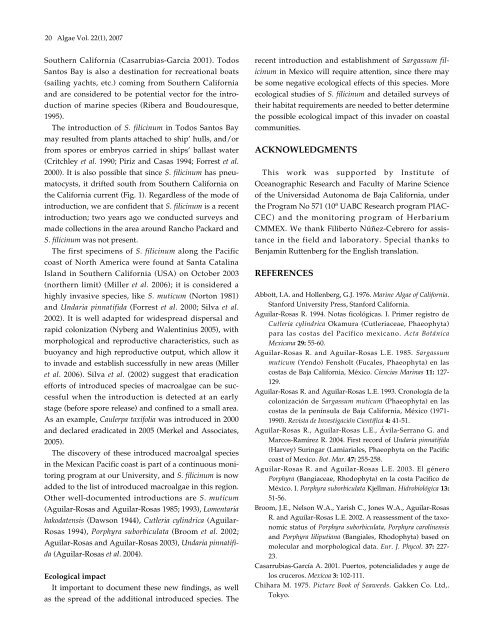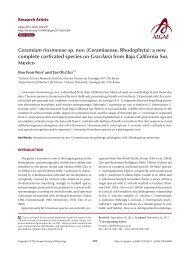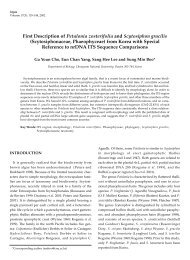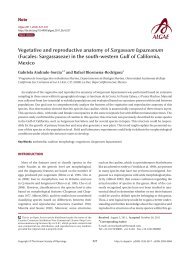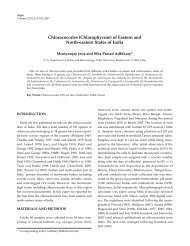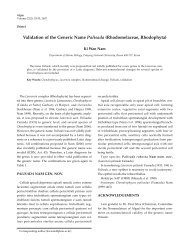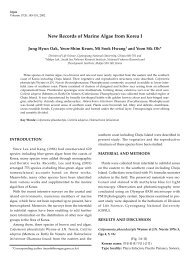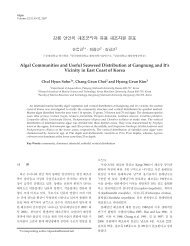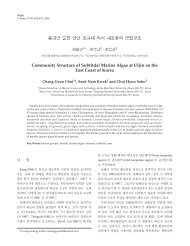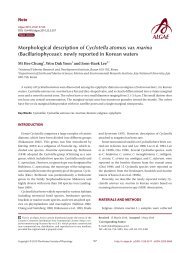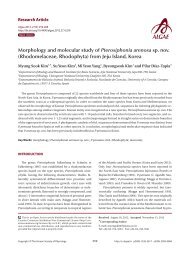New record of Sargassum filicinum Harvey (Fucales ... - Algae
New record of Sargassum filicinum Harvey (Fucales ... - Algae
New record of Sargassum filicinum Harvey (Fucales ... - Algae
You also want an ePaper? Increase the reach of your titles
YUMPU automatically turns print PDFs into web optimized ePapers that Google loves.
20 <strong>Algae</strong> Vol. 22(1), 2007<br />
Southern California (Casarrubias-Garcia 2001). Todos<br />
Santos Bay is also a destination for recreational boats<br />
(sailing yachts, etc.) coming from Southern California<br />
and are considered to be potential vector for the introduction<br />
<strong>of</strong> marine species (Ribera and Boudouresque,<br />
1995).<br />
The introduction <strong>of</strong> S. <strong>filicinum</strong> in Todos Santos Bay<br />
may resulted from plants attached to ship’ hulls, and/or<br />
from spores or embryos carried in ships’ ballast water<br />
(Critchley et al. 1990; Piriz and Casas 1994; Forrest et al.<br />
2000). It is also possible that since S. <strong>filicinum</strong> has pneumatocysts,<br />
it drifted south from Southern California on<br />
the California current (Fig. 1). Regardless <strong>of</strong> the mode <strong>of</strong><br />
introduction, we are confident that S. <strong>filicinum</strong> is a recent<br />
introduction; two years ago we conducted surveys and<br />
made collections in the area around Rancho Packard and<br />
S. <strong>filicinum</strong> was not present.<br />
The first specimens <strong>of</strong> S. <strong>filicinum</strong> along the Pacific<br />
coast <strong>of</strong> North America were found at Santa Catalina<br />
Island in Southern California (USA) on October 2003<br />
(northern limit) (Miller et al. 2006); it is considered a<br />
highly invasive species, like S. muticum (Norton 1981)<br />
and Undaria pinnatifida (Forrest et al. 2000; Silva et al.<br />
2002). It is well adapted for widespread dispersal and<br />
rapid colonization (Nyberg and Walentinius 2005), with<br />
morphological and reproductive characteristics, such as<br />
buoyancy and high reproductive output, which allow it<br />
to invade and establish successfully in new areas (Miller<br />
et al. 2006). Silva et al. (2002) suggest that eradication<br />
efforts <strong>of</strong> introduced species <strong>of</strong> macroalgae can be successful<br />
when the introduction is detected at an early<br />
stage (before spore release) and confined to a small area.<br />
As an example, Caulerpa taxifolia was introduced in 2000<br />
and declared eradicated in 2005 (Merkel and Associates,<br />
2005).<br />
The discovery <strong>of</strong> these introduced macroalgal species<br />
in the Mexican Pacific coast is part <strong>of</strong> a continuous monitoring<br />
program at our University, and S. <strong>filicinum</strong> is now<br />
added to the list <strong>of</strong> introduced macroalgae in this region.<br />
Other well-documented introductions are S. muticum<br />
(Aguilar-Rosas and Aguilar-Rosas 1985; 1993), Lomentaria<br />
hakodatensis (Dawson 1944), Cutleria cylindrica (Aguilar-<br />
Rosas 1994), Porphyra suborbiculata (Broom et al. 2002;<br />
Aguilar-Rosas and Aguilar-Rosas 2003), Undaria pinnatifida<br />
(Aguilar-Rosas et al. 2004).<br />
Ecological impact<br />
It important to document these new findings, as well<br />
as the spread <strong>of</strong> the additional introduced species. The<br />
recent introduction and establishment <strong>of</strong> <strong>Sargassum</strong> <strong>filicinum</strong><br />
in Mexico will require attention, since there may<br />
be some negative ecological effects <strong>of</strong> this species. More<br />
ecological studies <strong>of</strong> S. <strong>filicinum</strong> and detailed surveys <strong>of</strong><br />
their habitat requirements are needed to better determine<br />
the possible ecological impact <strong>of</strong> this invader on coastal<br />
communities.<br />
ACKNOWLEDGMENTS<br />
This work was supported by Institute <strong>of</strong><br />
Oceanographic Research and Faculty <strong>of</strong> Marine Science<br />
<strong>of</strong> the Universidad Autonoma de Baja California, under<br />
the Program No 571 (10 a UABC Research program PIAC-<br />
CEC) and the monitoring program <strong>of</strong> Herbarium<br />
CMMEX. We thank Filiberto Núñez-Cebrero for assistance<br />
in the field and laboratory. Special thanks to<br />
Benjamin Ruttenberg for the English translation.<br />
REFERENCES<br />
Abbott, I.A. and Hollenberg, G.J. 1976. Marine <strong>Algae</strong> <strong>of</strong> California.<br />
Stanford University Press, Stanford California.<br />
Aguilar-Rosas R. 1994. Notas ficológicas. I. Primer registro de<br />
Cutleria cylindrica Okamura (Cutleriaceae, Phaeophyta)<br />
para las costas del Pacífico mexicano. Acta Botánica<br />
Mexicana 29: 55-60.<br />
Aguilar-Rosas R. and Aguilar-Rosas L.E. 1985. <strong>Sargassum</strong><br />
muticum (Yendo) Fensholt (<strong>Fucales</strong>, Phaeophyta) en las<br />
costas de Baja California, México. Ciencias Marinas 11: 127-<br />
129.<br />
Aguilar-Rosas R. and Aguilar-Rosas L.E. 1993. Cronología de la<br />
colonización de <strong>Sargassum</strong> muticum (Phaeophyta) en las<br />
costas de la península de Baja California, México (1971-<br />
1990). Revista de Investigación Científica 4: 41-51.<br />
Aguilar-Rosas R., Aguilar-Rosas L.E., Ávila-Serrano G. and<br />
Marcos-Ramírez R. 2004. First <strong>record</strong> <strong>of</strong> Undaria pinnatifida<br />
(<strong>Harvey</strong>) Suringar (Lamiariales, Phaeophyta on the Pacific<br />
coast <strong>of</strong> Mexico. Bot. Mar. 47: 255-258.<br />
Aguilar-Rosas R. and Aguilar-Rosas L.E. 2003. El género<br />
Porphyra (Bangiaceae, Rhodophyta) en la costa Pacífico de<br />
México. I. Porphyra suborbiculata Kjellman. Hidrobiológica 13:<br />
51-56.<br />
Broom, J.E., Nelson W.A., Yarish C., Jones W.A., Aguilar-Rosas<br />
R. and Aguilar-Rosas L.E. 2002. A reassessment <strong>of</strong> the taxonomic<br />
status <strong>of</strong> Porphyra suborbiculata, Porphyra carolinensis<br />
and Porphyra liliputiana (Bangiales, Rhodophyta) based on<br />
molecular and morphological data. Eur. J. Phycol. 37: 227-<br />
23.<br />
Casarrubias-García A. 2001. Puertos, potencialidades y auge de<br />
los cruceros. Mexicoa 3: 102-111.<br />
Chihara M. 1975. Picture Book <strong>of</strong> Seaweeds. Gakken Co. Ltd,.<br />
Tokyo.


